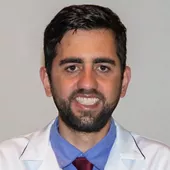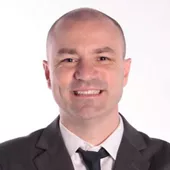Initial situation
A female patient, age 52, sought dental care with the aim of replace the upper removable prosthesis. (Figs. 1-2). The patient was unsatisfied with the low retention and aesthetics. The patient requested an immediate and fixed option to improve masticatory function.
Procedure
Treatment planning
The initial treatment plan involved the placement of BLT Straumann® dental implants to support an upper fixed hybrid prosthesis. The patient was referred for computed tomography using a double scan protocol with coDiagnostiX™ (Dental Wings, Chemnitz, Germany) (Figs. 3-5). The strategy of the virtual planning was to circumvent the right and left maxillary sinus with tilted and long implants and seek apical anchoring in the lower cortex of the nasal fossa, using a predictable, simple and accessible procedure for the patient, following the Straumann® Pro Arch concepts. The drill guide was designed and exported for 3D printing, being a tool to improve the positioning of the implants (Fig. 6).
Surgical procedure
Bilateral local anaesthesia was performed. The drill guide was stabilized using a bone grafting screw on the palate and two fixation pins on the buccal bone (Figs. 7-8). The sequential osteotomy preparation was completed to depth through the Straumann® BLT Guided Surgery tools (Figs. 9-12). Two BLT SLActive® implants (RC, 4.1mm diameter, 14mm) were placed in the regions of teeth #15 and #25. Three BLT SLActive® implants (RC, 4.1mm in diameter, 10mm) were placed in the regions of teeth #12, #21 and #22, both with torques greater than 60Ncm (Fig. 13). Two screw-retained abutments 4.6 x 4.0mm on implants in the regions of teeth #12 and #21, one Straumann® screw-retained abutment 4.6 x 2.5 mm in the region of tooth #22 and two Straumann® screw-retained abutments 4.6 x 4.0mm angled 17 degrees in the regions of teeth #15 and #25. Then, the multifunctional guide was placed in position to check the correct position of the implants and abutments (Fig. 14).
Prosthetic procedure
The patient received the prosthesis on the same day of the surgery. Temporary titanium cylinders were used to capture the patient's removable prosthesis using the Straumann® Pro Arch concept (Figs. 15-17). After a period of 1 year and 6 months, intraoral scanning was performed using the Straumann® Virtuo Vivo™ (Dental Wings, Montreal, Canada) (Figs. 18-20). The metal bar was designed using the CAD/CAM Straumann® CARES system and placed in the mouth to test the adaptation (Fig. 21-22). The prosthesis was completed following the laboratory steps. The occlusal screws were torqued to 15Ncm and the occlusion was adjusted to have uniform contacts in centric relation and balanced occlusion in excursion movements, and finally, the access holes for the screws were filled (Figs. 23-24). Two years after surgery, clinical and radiographic control was performed. The prosthesis was removed, the implants were tested individually, and postoperative radiographs were performed, with good bone stability (Figs. 25-28).
Treatment Outcome
In this case, the use of several digital tools, such as virtual planning, printing of a surgical guide, intraoral scanning and milling of a metal bar, helped in an important way in the treatment. It has been observed that the Straumann® guided surgery system provides a high level of accuracy for implant placement purposes. The tools of the Straumann® CARES system helped in the prosthetic restoration stage.

